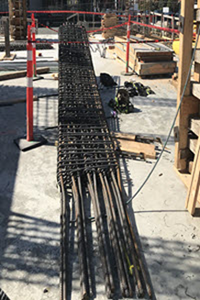Worker seriously injured when rebar cage collapsed
Date of incident: March 2020
Notice of incident number: 2020174000043
Employers: Construction labour supplier; rebar firms (2); concrete forming firms (2); crane operation provider; residential construction firm
Incident summary
A construction labour supply firm had provided workers to help install rebar to support concrete formwork at a residential construction site. The workers were attempting to place a rebar column cage over a set of dowels when the rigging attaching the cage to a tower crane broke, causing the cage to fall over onto the ground. A worker who had attached himself to the cage while it was suspended from the crane fell with the cage and was seriously injured when he and the cage hit the ground.
Investigation conclusions
Cause
- Rigging failed while worker was attached to suspended load. The wire rope sling used to lift the rebar column cage broke due to a combination of the load placed on the sling and the shearing action of the rebar cutting some of the sling’s wires. In an effort to get the cage to fit onto the dowels, workers climbed the cage while it was suspended and moved it around, which would account for the shearing action. When the sling broke, the cage fell to the ground, and the worker fell along with it.
Contributing factors
- Rigging not suitable for load. The rigger believed that the working load limit of the rigging was sufficient for the load being lifted. A WorkSafeBC engineer determined that the diameter of the rebar around which the sling was placed would have reduced the capacity of the sling due to the curvature of the sling. The resulting reduction in capacity meant that the weight of the load exceeded the working load limit of the sling. The workers were directed to climb onto the load while it was suspended from the crane, adding additional weight. The sling was also damaged by the rebar it was holding. There is evidence that it was common for the cages to get stuck and require some degree of manipulation to get them to fit onto the dowels. There is no evidence that the potential for the wire rope sling to be damaged by the rebar when the cages were moved was taken into account. Even if the sling had been capable of holding the weight of the column, some form of protection could have been applied to the sling to prevent it from being damaged by the rebar. Following the incident, the prime contractor ensured that a suitable chain was available for use in place of wire rope rigging.
- Congested rebar cage did not fit over dowels. The rebar column cage involved in this incident did not fit properly over the dowels, which resulted in workers climbing on and manipulating the cage in an attempt to make it fit. The existing safe work procedures did not take into account the challenges posed by congested column cages. After the incident, additional safe work procedures were created to specifically address erecting congested columns.
- Inadequate supervision. The proprietor of the construction labour supply firm, firm F, was supervising his firm’s workers as they attempted to land the rebar column cage. Workers were directed to climb the cage, which was contrary to the safe work procedures and also violated the Occupational Health and Safety Regulation, as the cage was suspended by the crane when the workers climbed on it. The proprietor of one of the rebar services firms, firm B, was the usual supervisor for the work of landing rebar column cages. He was not on site at the time of the incident and did not take steps to ensure that firm F’s proprietor was made aware of the safe work procedures for the work that was being performed.
- Failure to follow procedure for assigning or transferring work. The main firm carrying out structural steel work at the site, firm H, had subcontracted some of the work to another firm, firm B. In doing so, it had put in place measures to ensure workers’ health and safety on site. However, firm B in turn subcontracted some of its work to firm F. Firm H was not aware that firm F’s workers were at the site, and therefore was not able to provide oversight for those workers’ health and safety. Similarly, the prime contractor, firm A, had taken steps to ensure worker health and safety at the site, but was not notified as required by the Regulation that firm F’s workers were on site. Thus, there was no opportunity for firm A to provide firm F’s workers with a safety orientation or take other steps to ensure their health and safety.

